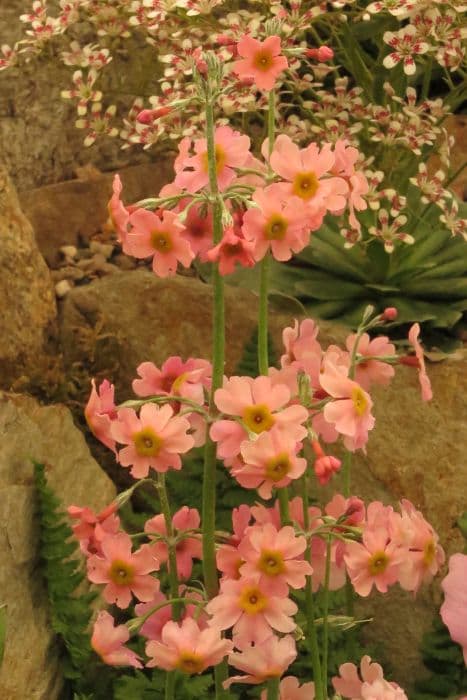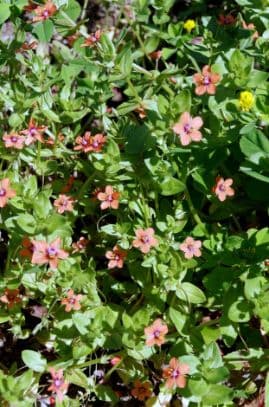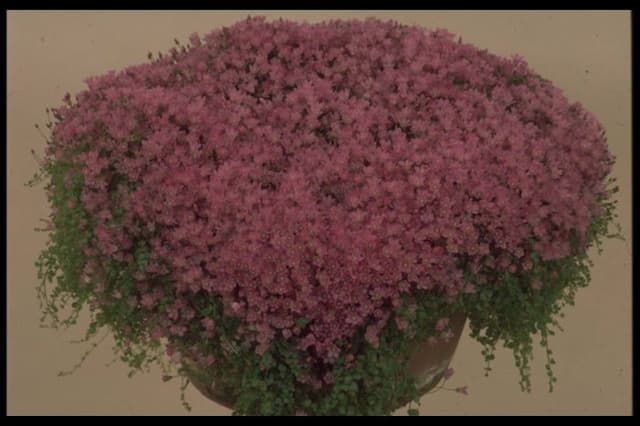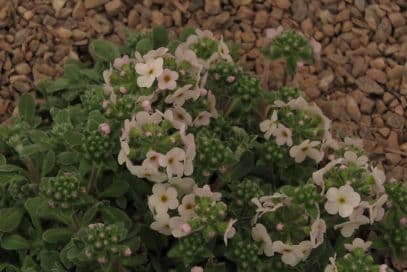Candelabra Primrose Primula pulverulenta Bartley hybrids (Pf)

ABOUT
The Primula pulverulenta, also known as candelabra primula, is an eye-catching perennial plant. It is recognized for its striking whorls of flowers, which are arranged in tiers circling the stem, similar to the shape of a candelabra. The flowers are vibrant and exhibit a range of colors from deep magenta to pink. The blossoms are small, rounded and packed tightly in each tier, creating an impressive display when they bloom in succession from the bottom to the top. These attractive flowers are complemented by the plant's lush green foliage. The leaves are long, with a tongue-like shape and a slightly ragged edge, forming a textured rosette close to the ground. Overall, the plant exudes a bold and elegant charm, bringing energy and color to any garden space where it is planted.
About this plant
 Names
NamesFamily
Primulaceae.
Synonyms
Bartley's Candelabra Primula, Candelabra Primrose.
Common names
Primula pulverulenta Bartley hybrids (Pf).
 Toxicity
ToxicityTo humans
The plant commonly known as candelabra primrose is not considered highly toxic to humans. However, ingestion of any part of the plant can potentially cause mild stomach upset and irritation. If ingested, one might experience symptoms such as nausea, vomiting, or diarrhea. While the plant is not severely poisonous, it is advisable to avoid eating any part of the candelabra primrose and to keep it out of reach of small children who might accidentally consume it.
To pets
Similar to its effects on humans, the candelabra primrose is not highly toxic to pets. However, if pets consume any part of this plant, they may experience mild gastrointestinal upset. Symptoms of ingestion may include vomiting, diarrhea, or drooling and usually are not severe. While the plant is not extremely dangerous, it is best to prevent pets from chewing on candelabra primrose to avoid any potential discomfort.
 Characteristics
CharacteristicsLife cycle
Perennials
Foliage type
Deciduous
Color of leaves
Green
Flower color
Mixed
Height
2 feet (60 cm)
Spread
1 foot (30 cm)
Plant type
Herb
Hardiness zones
5
Native area
China
Benefits
 General Benefits
General Benefits- Ornamental Value: The plant is known for its attractive flowers that enhance the visual appeal of gardens.
- Habitat for Wildlife: Provides nectar for pollinators such as bees and butterflies, supporting local ecosystems.
- Low Maintenance: Requires minimal care, making it suitable for gardeners of all skill levels.
- Tolerant of Various Conditions: Can thrive in a range of soil types and light conditions, adding to its versatility in landscaping.
- Long Blooming Season: Offers a long period of flowering time, which can add color to gardens for an extended duration.
 Medical Properties
Medical PropertiesThis plant is not used for medical purposes.
 Air-purifying Qualities
Air-purifying QualitiesThis plant is not specifically known for air purifying qualities.
 Other Uses
Other Uses- Container Gardening: Primula pulverulenta, commonly known as Bartley hybrids, is suitable for container gardening, adding a pop of color to balconies and patios.
- Edible Flowers: The flowers of the plant are edible and can be used to garnish salads, desserts, or drinks for a vibrant touch.
- Photography: The striking appearance of Primula pulverulenta makes it a favorite subject for garden photographers and botanical artists.
- Dye Production: Historically, some primula species were used to produce plant-based dyes for textiles, although specific use for Bartley hybrids isn't well-documented.
- Fairy Gardens: With their enchanting appearance, these flowers are ideal for creating magical fairy garden landscapes.
- Education: These plants can be used in educational settings to teach about pollination, as they attract insects such as bees and butterflies.
- Collectors: Primula pulverulenta is sought after by plant collectors due to its distinct color and pattern variations among the hybrids.
- Companion Planting: These plants can be beneficial when planted alongside vegetables in gardens as they may attract pollinators and potentially improve yields.
- Crafts: The flowers and leaves can be pressed and used in craft projects such as making bookmarks, greeting cards, or framed botanical art.
- Ice Cubes: Flowers can be frozen into ice cubes to create decorative elements for summer drinks and cocktails.
Interesting Facts
 Feng Shui
Feng ShuiThe Candelabra Primrose is not used in Feng Shui practice.
 Zodiac Sign Compitability
Zodiac Sign CompitabilityThe Candelabra Primrose is not used in astrology practice.
 Plant Symbolism
Plant Symbolism- Youthfulness: The Primula, or candelabra primrose, blooms early in the spring, representing the freshness and vitality associated with youth.
- Hope: As a herald of spring, this plant symbolizes hope and the anticipation of better things to come after a long winter.
- New beginnings: The candelabra primrose's role in the early spring garden makes it a symbol of starting anew or taking on new ventures.
- Variety: Bartley hybrids offer a range of colors, symbolizing diversity and the beauty of variety in life.
 Water
WaterThe Candelabra Primrose should be watered deeply and regularly to maintain moist soil, especially during the growing season in spring and summer. Aim to water approximately 1 inch per week, but adjust based on weather conditions; more water may be needed during hot, dry periods and less during cooler, rainy spells. It's critical not to let the soil dry out completely, as Candelabra Primroses enjoy consistent moisture. Avoid overhead watering to prevent foliage diseases; instead, water at the base of the plant.
 Light
LightThe Candelabra Primrose thrives in partial shade, where it receives dappled sunlight or light shade for most of the day. An ideal spot is one that mimics its natural woodland habitat, such as under the light shade of tall trees that filter the sunlight. It should be protected from the harsh afternoon sun, which can scorch its delicate leaves.
 Temperature
TemperatureThe Candelabra Primrose prefers cool temperatures and is hardy in an environment that ranges from about 40 degrees Fahrenheit to 75 degrees Fahrenheit. It can survive minimum temperatures of 20 degrees Fahrenheit, but it thrives in the cooler end of its temperature range. The ideal temperatures for promoting vigorous growth and flowering are between 50 and 70 degrees Fahrenheit.
 Pruning
PruningPruning the Candelabra Primrose is generally done to remove spent flower stalks and to tidy up dead or yellowing leaves. Deadheading the flowers once they fade encourages the plant to produce more blooms. Pruning is typically needed after the blooming period in late spring or early summer. Cut back the foliage in fall to prepare the plant for winter.
 Cleaning
CleaningAs needed
 Soil
SoilCandelabra Primrose prefers a rich, moist, humus-heavy and well-draining soil mix with a pH of 5.5-7. Amend garden soil with compost and peat moss to achieve these conditions.
 Repotting
RepottingCandelabra Primrose typically needs to be repotted every 1-2 years to provide fresh soil and room for growth.
 Humidity & Misting
Humidity & MistingCandelabra Primrose thrives at a higher humidity level, around 75-80%, to mimic its natural damp, woodland habitat.
 Suitable locations
Suitable locationsIndoor
Keep in bright, indirect light, with high humidity.
Outdoor
Plant in partial shade, keep soil moist.
Hardiness zone
5-7 USDA
 Life cycle
Life cycleThe life of the Primula pulverulenta, commonly known as candelabra primrose, begins with seed germination, typically in spring or early summer, where it requires a period of cold stratification to break dormancy. After germination, the plant grows a rosette of basal leaves and develops a root system. In the following year or sometimes the same year depending on conditions, it produces tall flowering stalks with whorls of flowers that range in color from pink to red, typically in late spring or early summer. After pollination, often by insects, the flowers produce capsules which contain numerous small seeds that are dispersed by wind or water. The candelabra primrose is a perennial plant, which means that after flowering, it can conserve energy in its roots and go dormant over the winter, only to regrow from the same rootstock the following spring. This cycle repeats annually, with the plant potentially expanding through self-seeding and forming larger clumps over time.
 Propogation
PropogationPropogation time
Spring to early summer
Propogation: Primula pulverulenta Bartley hybrids, commonly known as candelabra primula, is typically propagated through seed sowing. The best time to sow seeds is late winter to early spring, as the seeds require a period of cold stratification to germinate successfully. To propagate by seed, one should surface-sow the tiny seeds onto trays filled with a moist, well-draining seed starting mix, ensuring light reaches the seeds as this aids germination. Covering the tray with clear plastic wrap can help maintain humidity. It's crucial to keep the soil consistently moist but not waterlogged, and to provide gentle warmth. Germination may take anywhere from 14 to 30 days. Once seedlings are large enough to handle, they can be pricked out and potted on into individual pots to grow on before being transplanted outside.









